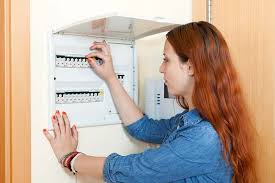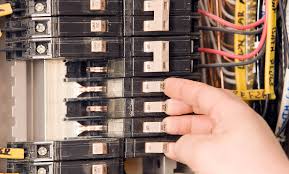What to Do When Your Circuit Breaker Trips
When a surge of energy overloads a circuit, like in the case of a lightning strike or heavily stressed outlet drawing too much current, the breaker’s safeguard is to switch the circuit to the OFF position. You can get your power back by following these three easy steps:
- Turn off all the lights and appliances affected by the power outage. Switch everything you can to the OFF position. If your TV went out and it doesn’t have a manual OFF switch, unplug it. It’s best not to have any electronics drawing electricity when the circuit breaker is reset (in step 3 below), or further damage could be done. The sudden surge of power could adversely affect your home computer, fan, or gaming system, for example.
- Find your circuit box and search for the breaker(s) in the OFF position. Some circuit breakers have a red or orange color if they are switched OFF.
- Flip the breaker from OFF to ON. Then, simply turn back on the appliances and devices you turned off in step 1, and you should be fine. If your circuit breaker keeps tripping, it’s time to call in an expert like Mr. Electric.
Does Your Circuit Breaker Keep Tripping?
If you circuit breaker keeps tripping, there could be a serious issue, often caused by general wear and tear on the circuit breaker itself, requiring that a new one be installed.
Repeated circuit breaker tripping caused by general wear and tear on the circuit breaker is usually due to one of the following issues:
- Short Circuit: A short circuit is common, but potentially dangerous. This is when a “hot wire” is contacting a neutral wire in an electrical outlet, which causes an overload of current to flow through the circuit, creating heat. The circuit breaker automatically shuts off in cases like these to prevent an electrical fire.
- Overloaded Circuit: Another common occurrence is a simple, overloaded circuit. If your electrical system or certain circuits can’t handle the amps coming through the circuit, it will flip the breaker, and possibly damage electronics or even start a fire.
- Ground Fault: This is when a hot wire and bare ground wire are both touching the metal box housing them. This sets off a chain reaction that pushes more electricity through the circuit than it’s supposed to hold, which repeatedly trips the breaker. A ground fault, or ground fault surge, will usually burn an outlet.

Safety First, Always First
The exact nature of electricity– that it cannot be detected with the eyes, ears, or the nose, yet if it is touched, it can kill– must be remembered at all times. Circuit breakers are very reliable components of an electrical system; however, they are man made and are subject to becoming defective. Proper lock-out-tag-out procedures must be followed when working on electrical circuits above 50 volts. Personnel protective equipment must be in serviceable condition and properly worn. Safety is a requirement, not an option, of every electrical task, large or small, be it routine or emergency in nature. Always use the three-step method when checking for voltage.
Take good care of your electrical test meters, having them checked at least every three years for insulation strength and for calibration as listed in the instruction booklet, or once a year otherwise. While a switch may visually indicate that the contacts have opened, a meter must be used to confirm that no voltage remains in the equipment to be worked on. Many times more than one source of power is provided to a machine. Some electrical circuits contain motor starting/running or power factor correction capacitors that may still be charged even after power has been removed from the circuit.

How to Address and Avoid Electrical Hazards at Home
Your home may be your castle, but even the coziest castles can harbor scary secrets — especially when it comes to your electrical system. Wires, circuit breakers, outlets, plugs — are you sure everything is safe and up to code?
Some possible electrical dangers to be aware of:
- Wires not properly grounded: All home wiring should have a wired connection to the ground. An electrical current always seeks the path of least resistance to the ground, and grounding provides a safe access route in the event of a product failure. An ungrounded circuit may allow current to stray from this intended path, increasing the risk of electric shock and serious injury.
- Aluminum wiring: It’s been illegal in most applications since 1978, but aluminum wiring — cheaper than copper — was popular in the early ’70s. Unlike copper, aluminum is soft and malleable, can get overheated easily and poses a potential fire hazard.
- Older homes or homes with remodeled additions: If your home ever underwent a do-it-yourself remodeling, or if the work was performed by a contractor who didn’t secure the right permits or follow proper codes, you may be at risk. Ask a licensed electrician to perform a safety inspection and address any hazards.
- The wrong size circuit breakers: Circuit breakers are safety devices, designed to trip — or turn off the power to a particular item or outlet — if too much electricity is flowing through a particular wire. Danger can result if there’s a mismatch between the size of the circuit breaker and the size of any wire.
Don’t Wait to Fix Electrical Hazards
Don’t take unnecessary chances. Call in a licensed electrician to make an inspection or repairs:
- If you suspect your house might have aluminum wiring, have a professional electrician investigate – this is not a DIY job
- If your home has been remodeled in the past, and you don’t know the history of the renovation
- If a particular outlet is not functioning or functions intermittently
- If an appliance or switch gives you an electric shock
- If your lights dim when the AC or another appliance comes on — a sign something is drawing too much current
- If you experience a burning smell or lights flickering in your home
- If you repeatedly trip circuit breakers

Installing Additional Circuit Breakers
You can add more circuits and circuit breakers inside your electrical service panel box as long as there are spaces. In many cases, the service panel will have available spaces. Some older homes may have completely filled out their spaces. In this case, an electrician can install a new, larger service panel box.
Generally, you can determine if there are more spaces by looking at the metal knock-outs on the panel itself. Any space that is not knocked out should be available for the insertion of another circuit breaker.
What is an Arc Fault?
An arc fault occurs when electricity is unintentionally released from home wiring, cords, or appliances because of damage or improper installation. This release of electricity can cause surrounding material to catch fire. According to the National Fire Protection Association, electrical arcing is the source of ignition in more than 30,000 fires annually. These fires are responsible for the deaths and injuries of hundreds of people and cause more than $750 million in direct property damage.
Top Causes of Arc Faults
- Loose or improper connections, such as electrical wires to outlets or switches
- Frayed appliance or extension cords • Pinched or pierced wire insulation, such as a wire inside a wall nipped by a nail or a chair leg sitting on an extension cord
- Cracked wire insulation stemming from age, heat, corrosion, or bending stress
- Overheated wires or cords
- Damaged electrical appliances